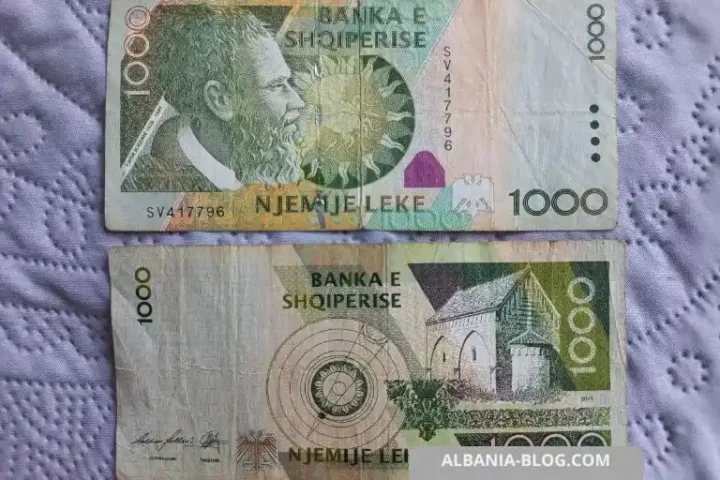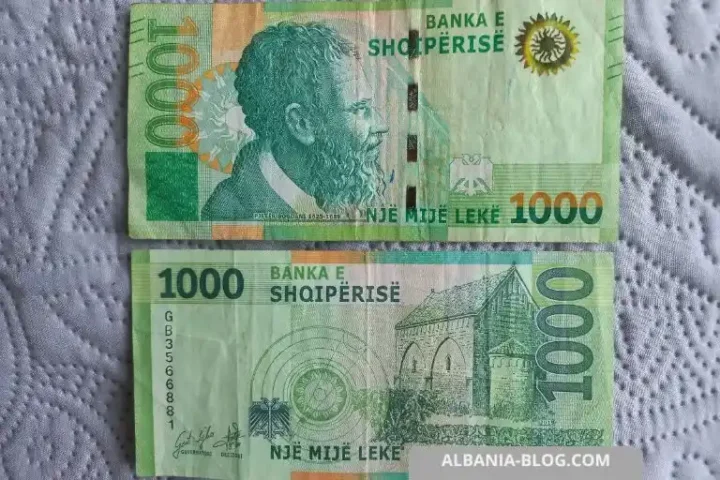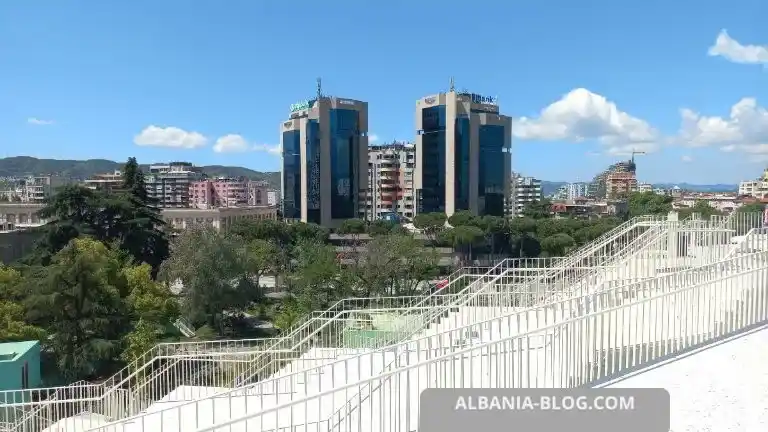The Albanian Lek (Lek) — The Official Currency of Albania

The international code is ALL, and in Albanian, it is written as Lekё (indefinite form), in English – Lek.
The Modern Albanian Currency
Albanian Coins
The official currency of Albania is the Albanian lek (Lek).
- The international symbol for the Albanian lek is: L
- International code: ALL
- In Albanian, the currency is written as Lekё (Lek).
Both paper banknotes and metal coins are in circulation.

Albanian Banknotes
Available denominations:
- Banknotes are printed in denominations of: 200, 500, 1000, 2000, 5000, 10000 lek.
- Coins are minted in denominations of: 1, 5, 10, 20, 50, 100 lek.
Money emission is conducted by the Bank of Albania.

History of the Albanian Lek
From 1913 to 1926
The first attempt to establish a National Bank of Albania was made by Ismail Qemali in 1913.
However, the First World War and financial chaos prevented this project.
Almost the entire territory of Albania, except for Vlorë, was engulfed by war in 1913.
Before 1926, different currencies were in circulation in Albania, including Austro-Hungarian, Italian, French currencies, or people would barter goods.
From 1926 to 1939
On September 2, 1925, the National Bank of Albania was established, and in 1926, the first gold coins of Albania were minted. They were called the “gold franc” (in Albanian “franga ari”) and had denominations of 10, 20, 50, and 100 francs.
The gold franc was introduced through an agreement between Albanian President Ahmet Zogu and Italian financial groups. The Albanian currency was named after the French franc.
On the front side of the coin, there was a profile of Ahmet Zogu, and on the back, there was a chariot with two horses. At the same time, paper banknotes of “gold francs” in denominations of 5, 20, and 100 francs were printed, also showing Ahmet Zogu’s profile.
During this period, the “gold franc” was backed by gold and could be freely converted into gold and vice versa. The economy of Albania at that time was developing fairly confidently.
The term “lek” for the currency was first used by Ahmet Zogu, who was initially Prime Minister (1922-1924), then President (1925-1928), and later King of Albania (1928-1939).
Some coins from that period feature Alexander the Great, with the inscription “lek,” the date 1931, and the letter “L” indicating the minting location in London. The letter “R” indicated Rome, and “V” represented Vienna.
Coins were minted in various capitals of the time, as Albania did not have its own mint.
From 1947 to 1991
After World War II, the communists came to power. In 1947, the use of the franc was abolished, and the national Albanian currency, the lek, became the only legal tender. The use of francs, including storage, was strictly prohibited.
Albanian lek: theories of origin
Why was the currency named “lek”?
There are two versions:
-
The first version suggests that the Albanian currency was named after the famous commander Alexander the Great. His name is written in Albanian as “Leka i madh,” which translates to “Alexander the Great.”
-
The second version proposes that the name came from Lekë Djukagjini, the founder of the “Kanun,” a set of customary laws. Ahmet Zogu was born in northern Albania, where Kanun traditions were strictly observed. Since 1450, every Albanian knew the rules of the Kanun, and the name “Lek” was familiar to all.
Kanun refers to a set of traditional laws, decisions made by a council of elders, which were mandatory for all citizens. Official laws were not considered; Kanun was supreme.
Zogu, who later became King, used the term “lek” to signify his desire to overcome challenges. This likely influenced the appearance of the term “lek” on some coins alongside Alexander the Great’s profile, as well as Ahmet Zogu’s profile.
Thus, the name “Albanian lek” was coined by King Zogu, who decided to engrave the word “Lek” on minted coins and banknotes.
Monetary Reform in 1965
In 1965, a monetary reform was implemented, where 10 old lek were exchanged for 1 new lek. New banknotes replaced the old ones, and the value decreased by one order of magnitude.
However, a problem remained—people had become so accustomed to the old values that even now they still use them in daily life.
Older generations continue to use old names for money. Instead of saying “hundred lek,” they say “thousand lek.” People still use the old terms out of habit.
When asked about an amount or price, the seller may take out a bill and show it to you. There’s no problem, but it may take some getting used to, especially if you’re a foreigner.
It’s important to know: To maintain understanding, Albanians continue using old denominations in conversation, and younger people also use them to communicate with older generations.
How Do Modern Albanian Banknotes Look
As of 2024, there are 6 denominations of banknotes in circulation: 200, 500, 1000, 2000, 5000, and 10000 lek. The banknotes feature prominent Albanian figures and important historical periods in their lives.
- 200 lek: Naima Frashëri (1846-1900) – renowned poet and patriot, symbol of the National Renaissance era.
- 500 lek: Ismail Qemali (1844-1919) – distinguished diplomat who devoted his life to the national cause and the creation of the Albanian state.
- 1000 lek: Pjetër Bogdani (1625–1689) – one of the most outstanding figures of Albanian medieval literature.
- 2000 lek: King Gent (ruled 181-168 BC and died in 146 BC) – a notable statesman, warrior, scholar, and doctor.
- 5000 lek: Gjergj Kastrioti, also known as Skanderbeg (1405-1468) – lord and prominent figure who led Albania’s resistance against Ottoman invasion, bringing about a decisive political shift.
- 10000 lek: Alexander Stavre Drenova, known as Asdreni (1872-1947) – publicist and activist, author of the Flag Hymn, which is now the national anthem of Albania.
What Tourists Need to Know About Albanian Currency
Banknotes: Two Series in Circulation
The First Series of Banknotes
There are two series of banknotes in circulation in Albania. Both are accepted for payment within the country.
Don’t be surprised if you receive two banknotes of the same value but with different appearances. This is normal.
The first series of modern lek banknotes was approved in 1995 and introduced in 1996. Over time, this series will be phased out.

The Second Series of Banknotes
The second series, with additional security features, was gradually introduced between 2019 and 2022. This series is designed for long-term circulation and may become the primary series in the future.
The banknotes in this series are slightly smaller than those of the previous one.

Card Payments and Cash Lek
In large cities, you can pay with a bank card. However, in markets, buses, and small shops, you will need cash.
Prices in markets can be either higher or lower than in stores. It’s best to look around and compare.
Albania has a strong seasonal demand for vegetables and fruits. Prices can double in spring.
Vegetables, fruits, and herbs are more affordable in private shops than in supermarkets.
Tip: Always carry some cash in lek.
In Vlora stores, payments by card are accepted if the purchase amount exceeds 500 lek. Purchases below 500 lek must be made in cash. This information is accurate as of 2024.
Tip: Be sure to exchange some money for cash lek to make payments at markets, on buses, in barbershops, or cafes.
Currency Exchange Points in Albania
Lek are prohibited from being exported from the country. Exchange them before leaving Albania.
Currency exchange points are located along city streets. The rates in such exchange offices are more favorable than at ATMs.
You can easily exchange euros or dollars for lek in any city. The working hours of exchange offices depend on the season, city, and foot traffic.

Currency Exchange Safety in Albania
There is no need to worry about the safety of currency exchange. Modern Albania is one of the safest countries in Europe. Tourists feel safe here.
Tip: Change money in advance. Street exchange offices may not operate at night. This is especially true in smaller cities.
Euro is the most preferred currency for exchange for several reasons:
- Euros are accepted in private stores for payment of goods;
- The territorial proximity to the European Union (EU);
- A large flow of tourists from European countries;
- Strong connections between businesspeople and EU countries;
- Planned EU accession by 2030.
The dollar ranks second. You can easily exchange it in any exchange office, just like euros. Albania has widely opened its doors to tourists from countries where the US dollar is used.
Currencies available for exchange in Albania’s exchange offices:
- Euro;
- US Dollars;
- French Franc;
- Swiss Franc;
- Australian Dollar;
- Canadian Dollar;
Tip: When traveling to Albania, bring some cash in euros or dollars. ATMs may charge high fees for card withdrawals.
You can withdraw money from your card at your bank without a fee, but banks in Albania usually operate from 8:30 AM to 2:30 PM. Saturday and Sunday are days off. You must also ensure that your bank has an office in the city.
As a rule, utility bills and mobile Internet are paid for at such points.
Currency exchange offices in Albanian cities look roughly the same.

What Money to Bring to Albania
The best option is a mix of cash euros and non-cash euros on your card.
The euro is widely used for payments. For example, apartments are valued in euros. Notaries can accept euros from you. In some shops or cafes you can pay in euros.
It is important to understand that paying in euros is an exception rather than a rule. The official currency of the country is the Albanian lek.
Albania has been a candidate for EU membership since 2014. The European Union has decided to accept several Balkan countries by 2030. Albania is actively preparing for EU membership.
The euro is the second most important currency in Albania after the lek.

Currency Transfers
Albania is on the list of countries where VISA and Mastercard cards are accepted.
The Western Union money transfer system is widely used.
The sole Western Union agent in Albania is the group UFT or Union Financiar Tirana. This group founded UnionBank and the payment processing system PayLink.
There is also a money transfer system called RIA Money Transfer (RIA).
RIA has a wide network of partner branches called EasyPay in Albanian cities. EasyPay is an electronic money institution licensed by the Bank of Albania. The system can be used to pay for various services in Albania.
There is no European CEPA system with very low fees in Albania. Albanians have to use other systems and pay higher percentages for transfers.
Anyone can make a money transfer from Albania to anywhere in the world.

Albanian Currency: The Future of the Lek
The following trends can be observed in the economy:
- Albania’s economy is growing.
- International investments in the economy are increasing.
- The number of tourists grows year by year.
- The EU accession requirements are being successfully met.
For these reasons, the Albanian lek is strengthening year by year.
For example, in 2021, 1 euro was worth 130 lek, in 2022 it was 120 lek, in 2023 it was 110 lek, in early 2024 it was 103 lek, and in early 2025 it is expected to be 98 lek.
A complex of factors is pushing the lek’s exchange rate to strengthen.
There is a high likelihood that the Albanian lek will continue to strengthen.

Come to Albania and explore the country!
- ✅ Discover nature and cities.
- ✅ Taste local cuisine.
- ✅ Hike the mountain trails and coastal paths.
Enjoy your journey and make unforgettable memories!
You can support the author and the project by donating via PayPal:






